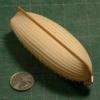-
Posts
13,303 -
Joined
-
Last visited
Content Type
Profiles
Forums
Gallery
Events
Everything posted by druxey
-

Frégate d'18 par Sané , la Cornélie
druxey replied to JohnE's topic in CAD and 3D Modelling/Drafting Plans with Software
Oh. I'm sorry to read of the reason for your hiatus. Wishing you restored and continuing good health, John. -

A Lorch Micro-Mill that never was ...
druxey replied to wefalck's topic in Modeling tools and Workshop Equipment
Sweet! -

Late 19th Century Merchants: Antifouling Paint Over Copper?
druxey replied to CDR_Ret's topic in Nautical/Naval History
Is it possible that what you are seeing in the photograph is thin wood sheathing painted over? -
Please, please do NOT use Gorilla glue!!! It's horrible stuff and expands like foam, so you will get seep-out no matter how careful you are. Use a little epoxy and clean off any smear with isopropanol before it sets. You'll be much happier. Also, should you plan on coloring the metal chemically, do this before you add it to the model.
-
Would alignment pins before/during assembly have prevented that problem? Looks good now!
-

planking repairs
druxey replied to bluenose2's topic in Building, Framing, Planking and plating a ships hull and deck
What wood and what finish have you used? -
Mark has described the style well. Hahn also used ebony (yech!) for his false keel and wales. This is not the best specie of wood for the job for a variety of reasons (discussed elsewhere), but avoids painting or staining.
- 968 replies
-
- hahn
- oliver cromwell
-
(and 1 more)
Tagged with:
-
Have you considered giving me the second model? Oh. It's spoken for. Lovely work, as ever.
-
Would running the scanner along some sort of track/gantry near the object being scanned and parallel to its long axis improve tracking?
- 9 replies
-
- scanning
- SolidWorks
- (and 4 more)
-
Presumably the plug is in pieces and once a central 'keystone' is extracted the other parts will come out easily - provided nothing has been glued to them!
-

HMS Naiad 1797 by albert - FINISHED - 1/48
druxey replied to albert's topic in - Build logs for subjects built 1751 - 1800
You've made a lot of progress in a few weeks, Albert. Looking fabulous. -

Frame construction
druxey replied to jbeyl's topic in Building, Framing, Planking and plating a ships hull and deck
Every scratch-built framed model is frightening when you look at the huge overall project. Just focus on one piece at a time in bite-sizes and, after a while, you will have eaten the whole elephant. -
Dan: every best wish with your health issues and for 'normality' again.
- 268 replies
-
Dental tools are also useful. A small elevator (looks like a tiny chisel with a bent end) is useful for scraping corners clean of any glue build-up.
-
Certainly there are plans of deck planking in such volumes as the plates in Steel's Naval Architecture. One can see that the outboard strakes are laid either top and butt or anchor stock where the gun carriages run across. Inboard are strakes that are laid either with three or four planks between butts on the same beam. Strakes are also tapered and curve, rather than the modern parallel and joggled style. A few strakes are laid short with a hook instead. If you are interested, a less expensive volume is the facsimile Rees' Naval Architecture, published in the 1970's. The plates are copied directly from Steel, but at 1:96 scale instead of 1:48. Copies of this useful reference can be found on such sites as abeboooks.com
-
Thanks for your thoughts on this discovery, E&T. I'm looking forward to more pictures and information on the find. The fact that the hatches were battened down and the ship relatively intact is interesting. Does this imply that the ship was abandoned in an orderly manner? Were there plans to return to her? So many unanswered questions - for the moment.
- 346 replies
-
- terror
- polar exploration
-
(and 2 more)
Tagged with:
-
The news was announced today that HMS Terror has been found in a remote bay near Nunavit. Apparently the wreck is in 'pristine' condition.
-

A Lorch Micro-Mill that never was ...
druxey replied to wefalck's topic in Modeling tools and Workshop Equipment
Very elegant!
About us
Modelshipworld - Advancing Ship Modeling through Research
SSL Secured
Your security is important for us so this Website is SSL-Secured
NRG Mailing Address
Nautical Research Guild
237 South Lincoln Street
Westmont IL, 60559-1917
Model Ship World ® and the MSW logo are Registered Trademarks, and belong to the Nautical Research Guild (United States Patent and Trademark Office: No. 6,929,264 & No. 6,929,274, registered Dec. 20, 2022)
Helpful Links
About the NRG
If you enjoy building ship models that are historically accurate as well as beautiful, then The Nautical Research Guild (NRG) is just right for you.
The Guild is a non-profit educational organization whose mission is to “Advance Ship Modeling Through Research”. We provide support to our members in their efforts to raise the quality of their model ships.
The Nautical Research Guild has published our world-renowned quarterly magazine, The Nautical Research Journal, since 1955. The pages of the Journal are full of articles by accomplished ship modelers who show you how they create those exquisite details on their models, and by maritime historians who show you the correct details to build. The Journal is available in both print and digital editions. Go to the NRG web site (www.thenrg.org) to download a complimentary digital copy of the Journal. The NRG also publishes plan sets, books and compilations of back issues of the Journal and the former Ships in Scale and Model Ship Builder magazines.



